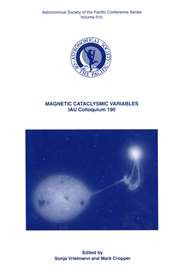No CrossRef data available.
Article contents
The 1987 Outburst of the Recurrent Nova U SCO
Published online by Cambridge University Press: 12 April 2016
Abstract
Core share and HTML view are not available for this content. However, as you have access to this content, a full PDF is available via the ‘Save PDF’ action button.
Spectral observations obtained soon after the 1987 brightening of U Sco support a thermonuclear runaway model for outbursts of this object. Spectra later in the decline are, however, more characteristic of a hot accretion disc. These observations are reconciled in a model where the low-mass high-velocity shell ejected from the surface of the white dwarf collides with the accretion disc causing it to brighten.
Information
- Type
- Session 5. Symbiotic Phenomena and Stellar Evolution. Conclusions.
- Information
- International Astronomical Union Colloquium , Volume 103: The Symbiotic Phenomenon , 1988 , pp. 337 - 338
- Copyright
- Copyright © Kluwer 1988

